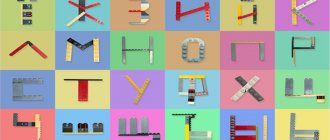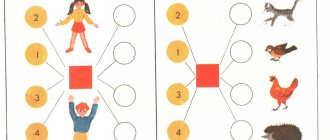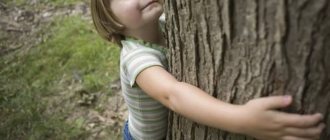Ecological experiments in preschool educational institutions
Thus, in order to develop experimental abilities, it is necessary to form a new type of child with new ecological thinking, capable of realizing the consequences of his actions in relation to the environment and able to live in relative harmony with nature.
II. Practical part.
But in practice, sometimes you come across the intellectual passivity of children, the reasons for which lie in the limited impressions and interests of the child. Sometimes they are not able to cope with the simplest task, but they quickly complete it if it is translated into practical activities or games.
(Participants go to the “laboratory”).
I bring to your attention a fairy tale with problematic questions that need to be answered with the help of experiments. (During the course of the story, the teachers walk with the presenter and perform experiments and see what happens.
).
The tale is called:
"The Journey of a Chicken, or the World Beyond the Fence of the Poultry Yard."
In a village, in a poultry yard, there lived a very curious chicken. His brothers and sisters were very obedient, and he stuck his nose in everywhere. One day he wanted to know what was behind the fence of the poultry yard, and he went to discover the world.
Having gone beyond the fence, he went along the path and suddenly he noticed a small fly on the ground. He wanted to take a closer look. How can this be done? Guys, who has a magnifying glass? Let's do it ourselves.
Experience No. 1
.
( You need to take a three-liter jar. Cover the neck with cling film, but do not pull it, but rather push it through so that a small container is formed. Tie the film with a rope or elastic band, and pour water into the recess. Conclusion: if you look at the water through the cling film , then we get the effect of a magnifying glass. The same effect will be obtained if you look at an object through a jar of water, securing it to the back wall of the jar with transparent tape.
) So we saw a fly.
Nearby, the chicken saw a small lake, many mysterious flowers floated in it, these were water lilies. Then the chicken saw that the fish appeared on the surface of the water and then disappeared again. Explain how they do this?
Experiment No. 3
( Take a glass of fresh sparkling water or lemonade, and throw a grape into it. It is slightly heavier than water and will sink to the bottom. But gas bubbles, like small balloons, will immediately begin to settle on it. Soon there will be so many of them, that the grape will float. Why does this happen? Conclusion: the bubbles on the surface will burst, the gas will fly away. The heavy grape will sink to the bottom again. Here it will again be covered with gas bubbles and float up again. This will continue several times until the water “fizzles out.” In fish there is a swim bladder, when it needs to dive, the muscles contract, compress the bubble, the volume decreases, the fish sinks down. But it needs to rise to the surface - the muscles relax, the bubble dissolves. It increases and the fish floats up.)
More crafts on the theme of ecology
In 2016, the President of Russia signed a decree declaring 2017 the year of ecology. The purpose of this order is to draw attention to the problems of environmental pollution and increase eco-literacy among the population. Including among students of school and preschool educational institutions.
The goal is to show the recycling of resources using an accessible example.
Note!
- Do-it-yourself owl - how to sew an owl, an owlet, an owl silhouette from fabric. Simple ways to create crafts
Autumn crafts for the autumn holiday from leaves, fesalis, plasticine, vegetables - come up with a creative name, create masterpieces
What craft materials to use for creativity: non-traditional, foamed, soft or natural pieces made by yourself
Everything you need is most likely at home and waiting for its turn on the way to the trash container.
Panel nest with birds
You will need:
- disposable paper plate;
- flaps of dense fabric. Felt will do;
- branches, pieces of tree bark, long needles of coniferous trees;
- cotton wool;
- glue.
Take a large diameter dish. Stick a bird figurine on it. Pre-cut it from thick fabric. Now cover the bottom of the bird with branches, bark, and needles, forming a nest. The final stage will be the formation of eggs from lumps of cotton wool. This is one of the options for making animals from natural material with your own hands.
Aquarium from disposable plates
Required components:
- disposable plates;
- scissors;
- glue;
- paints.
One of the plates will become the main one for the body of the fish, the second - for the fin and tail. Cut out the elements, paint in the chosen color, dry well. Then cut a triangular shaped segment. This will be the fish's mouth. Attach the parts with glue and draw the eyes. Crafts on the theme of nature will occupy the younger and older generations equally.
Forest crafts
Boletus from cereals
For the mushroom you will need:
- multi-colored cardboard;
- template for boletus;
- green and red lentils;
- millet;
- semolina;
Step-by-step actions
- Cut out a template from plain paper.
- Transfer the image onto colored cardboard using a pencil.
- Apply PVA to part of the boletus cap and place red lentils on it. Press down a little with your fingers.
- Apply glue to the remaining half of the cap and distribute the beans in the same way. For a clear example, use pictures from natural materials in grades 2–4, made by elementary school students.
- Fill the inside of the cap, which is visible, with glue and millet.
- Cover the mushroom stem with semolina and PVA.
- Form a clearing around the boletus using PVA and green beans.
- Dry. The nature-themed craft is ready.
Master class: bouquet of flowers in a vase
Another option for making decorative items from waste components.
This creativity will be interesting to 5th grade students and anyone who likes to make homemade interior items.
Target
To clearly demonstrate that most people throw away plastic bottles in vain. This is a very good material for creativity. With the help of your imagination and simple improvised components, you can give a second life to many household wastes.
You will need:
- egg trays;
- sticks for stems or wire;
- gouache;
- kefir bottle;
- satin ribbon;
- bag or foil packaging (needed to create an ornament on the vase)
Step-by-step making of crafts on the topic of ecology with your own hands
- Separate the pieces of egg packaging. You need 15-21 hemispheres.
- Fold in half, rounding off sharp corners.
- For one flower you will need 3 such blanks.
- We form leaves on two cups, straightening them with our fingers.
- At the third cup, cut off the lower hemisphere and roll up the resulting ribbon with petals.
- Color the resulting details. Dry well.
- Add a drop of glue to the base of the cups and connect the elements one by one. Place a bead in the core.
- Color the stem green. Dry.
- Place the buds on the stem.
A craft on the theme of taking care of nature is almost ready. There are a few steps left.
- Remove any labels from the bottle.
- Cut off the top of the container.
- Cut out the pattern from the packaging.
- Glue a strip of the pattern to the top and bottom of the vase, and tie the middle with a satin ribbon.
- Place the roses in the vase.
Folk art crafts do not require economic costs and will develop creativity and imagination. Such works are designed to inspire people to reuse unnecessary things. Recycled, they can last much longer. Caring for natural resources plays an important role in ecosystem restoration. Many household wastes have a very long decomposition period, which negatively affects the ecology of the planet.
Below are pictures of crafts made from natural materials.




